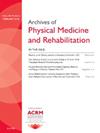Screening by Pediatric Therapists Establishes Hospital-wide Burden of Delirium in Children 4357
IF 3.6
2区 医学
Q1 REHABILITATION
Archives of physical medicine and rehabilitation
Pub Date : 2025-04-01
DOI:10.1016/j.apmr.2025.01.033
引用次数: 0
Abstract
Objectives
To identify the rate of positive delirium screens in children across pediatric hospital settings. A secondary objective was to establish feasibility of delirium screening by pediatric therapists (physical therapists, occupational therapists, speech therapists) during routine clinical assessments of hospitalized children.
Design
Quality Improvement Project.
Setting
Free-standing, academic-affiliated health care system that includes 2 pediatric campuses in the Southern United States.
Participants
All children referred for therapy (physical therapy, occupational therapy, and/or speech therapy) between February 19, 2023, to June 4, 2023. Therapy services are provided in all in-patient pediatric units.
Interventions
All physical, occupational, and speech therapists in our acute care pediatric medical center were trained to use the Cornell Assessment of Pediatric Delirium (CAPD), an observational delirium screening tool validated for use in children of all ages and developmental stages. Delirium screening was then implemented as standard of care hospital-wide. Each child had a CAPD scored at the end of every therapy session.
Main Outcome Measures
A CAPD score of 9 or higher is consistent with a diagnosis of delirium.
Results
During the 15-week study period, 1259 delirium screens were completed on 791 unique patients. Twenty-five percent of delirium screens were positive (316/1259). When considering only the first delirium screen per unique patient, incidence of delirium remained similar at 20% (162/791 patients). Delirium was diagnosed in every pediatric unit, with highest rates noted in the pediatric and neonatal intensive care units. Therapists were able to complete delirium screening in more than 95% of patient encounters (1305/1361 screens performed).
Conclusions
In this cohort, delirium rate was 20% overall, suggesting that there may be a role for delirium screening in all inpatient pediatric units. Our single-center experience demonstrates that delirium screening by pediatric therapists is highly feasible. Therapists may be a practical, underleveraged, and valuable resource to operationalize pediatric delirium screening hospital-wide.
Disclosures
none.
求助全文
约1分钟内获得全文
求助全文
来源期刊
CiteScore
6.20
自引率
4.70%
发文量
495
审稿时长
38 days
期刊介绍:
The Archives of Physical Medicine and Rehabilitation publishes original, peer-reviewed research and clinical reports on important trends and developments in physical medicine and rehabilitation and related fields. This international journal brings researchers and clinicians authoritative information on the therapeutic utilization of physical, behavioral and pharmaceutical agents in providing comprehensive care for individuals with chronic illness and disabilities.
Archives began publication in 1920, publishes monthly, and is the official journal of the American Congress of Rehabilitation Medicine. Its papers are cited more often than any other rehabilitation journal.

 求助内容:
求助内容: 应助结果提醒方式:
应助结果提醒方式:


